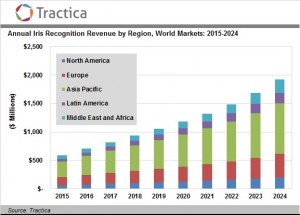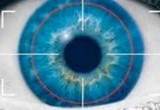Iris market predictions, Brazilian airports deploying face recognition
16 July, 2015
category: Biometrics, Digital ID, Government
Iris recognition market predictions
 Tractica released a report examining the iris biometric market and its growth over the next few years. Starting from a base of $587 million in 2015, global iris recognition revenue is forecast to reach $1.92 billion by 2024, with cumulative revenue for the 10-year period totaling $11.7 billion at a compound annual growth rate of 14%.
Tractica released a report examining the iris biometric market and its growth over the next few years. Starting from a base of $587 million in 2015, global iris recognition revenue is forecast to reach $1.92 billion by 2024, with cumulative revenue for the 10-year period totaling $11.7 billion at a compound annual growth rate of 14%.
This report looks at the market for iris recognition biometrics hardware, including 10-year forecasts for the period from 2015 through 2024. The report examines 20-use cases specific to iris recognition. The report forecasts revenue and device shipments for standalone devices and integration into mobile devices. Within each world region, market forecasts are further segmented by industry and use case, to suggest where the opportunities lie. The report also includes profiles of 18 industry players in the iris recognition market.
Iris recognition has traditionally been the domain of purpose-built devices such as immigration kiosks, cash dispensers, and biometrics jump kits used by soldiers in forward situations. These devices are expensive, in part due to their usage environments. However, the recent availability of iris imaging onboard mobile devices is likely to expand its use cases at small incremental cost.
Key questions addressed in the report include:
- What is the size of the market for iris recognition devices by region, industry, and use case?
- What are the likely device shipments and revenue for standalone iris recognition devices by region, industry, and use case?
- What are the likely device shipments and revenue for mobile device iris imaging components by region, industry, and use case?
- Which industries represent the largest potential markets for iris recognition?
- What are the key use cases that will drive growth of the iris recognition market?
- How do iris recognition products differentiate themselves?
Brazil airports deploying face recognition
NEC Corp. announced its selection by the Brazilian National Tax Collection Agency to provide NeoFace Watch facial recognition technology for 14 international airports throughout Brazil in order to enhance the effectiveness and efficiency of customs procedures. The system will be used to spot individuals who have been registered for suspect activity.
NEC’s NeoFace Watch enables automatic facial recognition through photos, CCTV images, recorded videos and webcams. It can be applied across a wide range of businesses to identify people both for security purpose and in customer relationship management, positioning itself as a flexible platform that aims to meet the needs of companies and governments alike.
For this project, NEC will deliver facial recognition systems that consist of NeoFace Watch software, CCTV cameras, servers and network infrastructure, as well as integration services for Receita Federal’s existing systems and maintenance services.
Brazilian international airports that will adopt the NeoFace Watch solution include:
- Tancredo Neves (Belo Horizonte – Minas Gerais)
- Juscelino Kubitschek (Brasilia – Distrito Federal)
- Viracopos (Campinas – Sao Paulo)
- Afonso Pena (Curitiba – Parana)
- Hercilio Luz (Florianopolis – Santa Catarina)
- Pinto Martins (Fortaleza – Ceara)
- Eduardo Gomes (Manaus – Amazonas)
- Augusto Severo, (Natal – Rio Grande do Norte)
- Salgado Filho (Porto Alegre – Rio Grande do Sul)
- Gilberto Freyre/ Guararapes (Recife – Pernambuco)
- Antonio Carlos Jobim/ Galeao (Rio de Janeiro – Rio de Janeiro)
- Dep. Luis Eduardo Magalhaes (Salvador – Bahia)
- Governador Andre Franco Montoro/Cumbica (Guarulhos – Sao Paulo)
- Cataratas (Foz do Iguacu – Parana)
FIDO Alliance, Bluetooth group sign agreement
The FIDO Alliance entered into a memorandum of understanding with the Bluetooth Special Interest Group (SIG) to use Bluetooth Smart as an alternative to a USB dongle in Universal Second Factor (U2F) authentication. The goal of the memo is to contribute to specifications for FIDO U2F over Bluetooth Smart that will extend the reach of FIDO U2F from the desktop to the mobile device.
Mobile devices carry a range of personal information and are being outfitted with simpler, stronger local device authentication. Currently, options to secure or “lock” mobile devices are a PIN, a gesture, or biometric authentication. The FIDO Alliance and Bluetooth SIG memo looks to use the local device for online authentication.
“There are more than eight billion Bluetooth enabled devices in use today around the globe and more than 10 billion are projected to ship in the next three years. This near-universal presence and the strong security built into Bluetooth Smart make the technology a natural choice for this innovative approach to multi-factor authentication,” said Errett Kroeter, senior director of marketing at the Bluetooth SIG.




